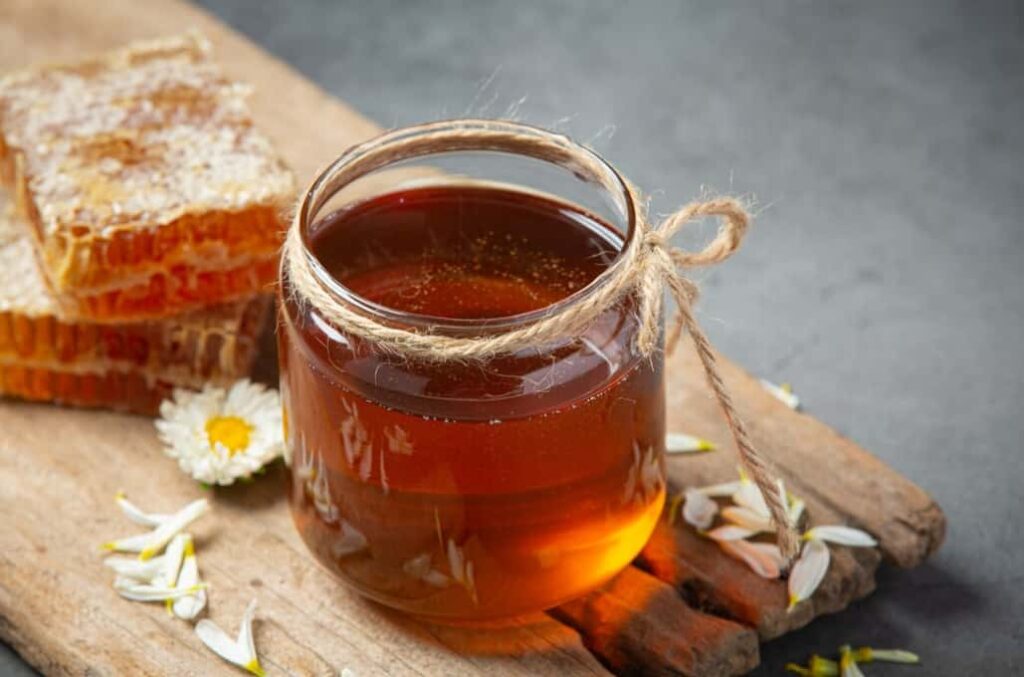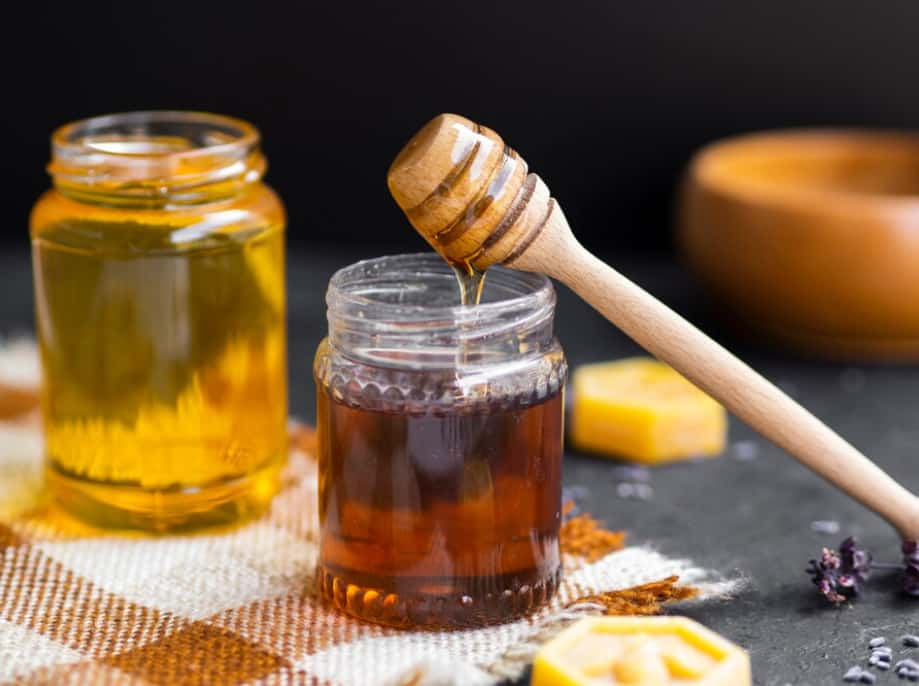Honey bees create dark honey in the same way as other honeys, by gathering nectar from specific flowers whose nectar and pollen are darker. The type of flowers the bees visit affects the color of the honey, and this varies with the seasons. Some well-known flowers known for yielding the darkest honey include Buckwheat, Avocado, Beechwood, Chestnut, Dandelion, Jarrah, Macadamia Nut, Manuka, Tulip Poplar, Blackbutt, Heather, and Goldenrod. These flowers contribute to the high levels of antioxidants and essential minerals found in dark honey, which typically has a deep brown or amber hue. Identifying flowers that yield the darkest honey unveils captivating facets of plant life, paralleling the insights gained from exploring the pecan tree production lifecycle.
Dark honey, in comparison to its lighter counterparts, tends to have a lower water content and a higher concentration of antioxidants. People continue to value honey for its antibacterial and anti-inflammatory properties.
Which Flowers That Produce Dark Honey?
Honey’s flavor profile is often linked to its color. Light honeys are typically mild in taste, while darker varieties tend to have richer, caramel-like undertones.
The color spectrum of honey ranges from nearly translucent, whitish shades in light honey to deep brown or amber tones in dark varieties. Dark honeys are generally more robust and pungent in flavor compared to their lighter counterparts.
While all honey contains beneficial minerals and antioxidants, some darker varieties boast higher concentrations of these nutrients. Similar to grading systems used for products like maple syrup, the USDA categorizes honey into various types based on color. To determine a honey’s color grade, a tool known as the Pfund Grader is used. The categories include:
- Water white;
- Extra white;
- White;
- Extra light amber;
- Light amber;
- Amber;
- Dark amber.
The Diversity of Honey Colors
The spectrum of honey hues, especially its deeper shades, is largely a result of the specific flora visited by bees. These plants often have darker pollen and nectar, which directly influences the color of the honey. The mineral content in these plants, which varies from one floral source to another, further adds to the color variation.
- Beekeepers notice that the color of honey changes with the seasons, mirroring the shift in flowers that bees forage from. Over time, honey stored within the comb can also become darker due to natural oxidation;
- The journey of minerals into honey begins with the soil and its environment, from which plants absorb these minerals. Bees, through their pollination, transfer these minerals from the plants to the honey;
- Honey’s antioxidant properties are crucial for health, offering protection against the harmful effects of free radicals. It also contains trace minerals vital for numerous bodily functions;
- Darker varieties of honey, in particular, are abundant in antioxidants such as flavonoids, phenolic acids, and enzymes, often surpassing lighter honeys in these respects. This nutritional density transforms honey from merely a sweet condiment to a healthful component of a balanced diet.
Buckwheat Honey
Among the darkest of honeys, Buckwheat honey stands out with its intense purple to almost black coloration. It offers a unique, nearly bitter taste, distinguishing it from the typical sweetness associated with honey.
Avocado Honey
Avocado honey boasts a deep amber shade and is known for its rich, buttery flavor. Despite its slight bitterness, it retains the classic sweet undertone of honey, offering a complex taste profile.

Beechwood Honey
Characterized by a stunning dark amber color, Beechwood honey is notable for its berry and caramel flavor notes, adding a distinctive twist to the usual honey taste. This variety is produced using sap from the Beech scale insect, which might sound unorthodox but results in a honey with minimal pollen content. Beechwood honey is also recognized for its high mineral concentration, higher than many other honey types. The process involves Beech scale insects feeding on the sugar-rich leaves of Beechwood trees. They excrete excess sugar, which then crystallizes on the tree’s bark, forming sap droplets later collected for honey production. This unique process contributes to the distinct characteristics of Beechwood honey.
Chestnut
Chestnut honey, notable for its deep, almost brown hue, offers a robust, nutty, and sometimes peppery flavor profile. Known for its significant pollen grain content, this honey can range from slightly bitter to very intense in taste, accompanied by a unique aroma. It’s a powerhouse of nutrients, rich in minerals, B vitamins, vitamin C, and iron, and has a high fructose content. This variety, particularly abundant in fructose and trace elements like potassium, magnesium, manganese, and barium, is celebrated for its natural antimicrobial properties. Due to its low glycemic index and subtle sweetness, chestnut honey is a suitable choice for diabetics.
Dandelion Honey
Dandelion honey, with its dark amber color and intense flavor, is known for its rapid crystallization due to high glucose levels. As it crystallizes, it transforms from a bright golden yellow to a deeper shade. The flavor is distinctively sharp and bitter, reminiscent of dandelion flowers, yet more potent. It offers medium sweetness and a lingering, slightly astringent aftertaste. Its creamy, buttery texture makes it an excellent complement to toast for a delightful breakfast experience.
Jarrah Honey
Produced from the nectar of Jarrah trees, this honey variety has an amber color and a rich, nutty, malt-like flavor. Jarrah honey is esteemed for its therapeutic qualities, including antibacterial and antifungal properties. Gaining popularity for its medicinal benefits and low glucose content, Jarrah honey has a unique ability to resist dehydration, creating an inhospitable environment for bacteria. This makes it a sought-after variety for both its taste and health benefits.
Macadamia Nut Honey
This variety boasts a deep amber hue and a flavor profile more robust than its lighter counterparts. It resembles caramel in texture and richness, making it an ideal alternative to molasses and similar sweeteners. The distinct macadamia essence adds a tangy, tropical twist to its sweetness.
Manuka Honey
Manuka honey is characterized by its dark cream to brown color, a herb-like flavor profile, and a subtly bitter aftertaste. It’s less sweet compared to standard table honey and typically has a much firmer consistency, unlike the more fluid table honey.
Tulip Poplar (Yellow Poplar) Honey
Tulip poplar honey, a dark amber delight, offers a gentler flavor compared to other dark honeys. It provides a pleasant, moderate sweetness, differing from the typically more intense flavors of darker varieties. Though its potent, dark honey is less favored for human consumption, it serves well in nurturing brood.
Tulip Poplar Blooming Season
The tulip poplar trees, capable of reaching heights exceeding 100 feet, blossom from late April to early May. These trees are adorned with large, cup-shaped flowers that occasionally produce abundant nectar.
Eucalyptus Blackbutt Honey
Derived from the Eucalyptus Blackbutt tree, this honey is known for its rich, syrup-like taste and thick consistency. It is also noted for its potent antibacterial properties, making it a distinctive choice among honey varieties.
Heather Honey
This type of honey features a dark amber color and is recognized for its robust, slightly bitter taste. Like many dark honeys, it is rich in minerals, contributing to its unique flavor and health benefits.
Wildflower Goldenrod Honey
Originating from the nectar of goldenrod plants, this honey is distinguished by its intense wildflower flavor and dark color. It is particularly high in protein and minerals, making it a nutritious and flavorful option.
Identifying the Most Intensely Hued Honey Variety

Buckwheat honey stands out as the darkest variety of honey, predominantly produced in regions like Minnesota, Ohio, and Wisconsin in the United States, as well as in parts of eastern Canada. This dark, rich honey is also cultivated along the East Coast, from Pennsylvania to New York.
Characterized by its reddish to near-black hue, buckwheat honey is known for its almost bitter taste. While it’s less sweet compared to other wildflower honeys, it boasts a more robust and peppery flavor, along with a thick, crystallized texture.
What contributes to its distinctive dark color are the polyphenols, similar to those found in red wine, dark chocolate, select teas, and berries. This rich coloration is a hallmark of its deep flavor profile.
Buckwheat honey is celebrated for its high iron content and other essential nutrients, making it a popular choice for health-conscious consumers. Its antioxidant levels are notably high; for instance, compared to sage-derived honey, buckwheat honey has up to 20 times more antioxidants.
This honey is also recognized for its medicinal benefits, including treating coughs and sore throats. Its potential to lower blood sugar levels makes it a favorable option for those managing diabetes.
In culinary circles, buckwheat honey is lauded for its unique flavor profile, often considered one of the best choices for crafting mead, an alcoholic beverage made from fermented honey. Its rich taste also makes it an excellent glaze for various meats, enhancing their flavor with its deep, complex notes.
Conclusion
The profound health advantages and distinctive taste of dark honey are a testament to the incredible contribution of honeybees to our diets. When you encounter a jar of dark honey, it’s a reminder of its origins – from the richly pigmented pollen and nectar of certain flowers, through the diligent efforts of honeybees, to the skilled beekeepers who ensure its high quality and purity.
Dark honey is an extraordinary gift from nature, enriched with a wide array of health benefits and intricate flavors from diverse flowering plants. Each type, be it the antioxidant-laden buckwheat honey, the deep-flavored chestnut variety, or the distinctively tasty beechwood honey, offers substantial nutritional value. Adding dark honey to your diet can enhance your culinary experience while boosting your health, thanks to its essential minerals and antioxidants. This ingredient is a showcase of nature’s bounty and the amazing work of our small but industrious pollinators.